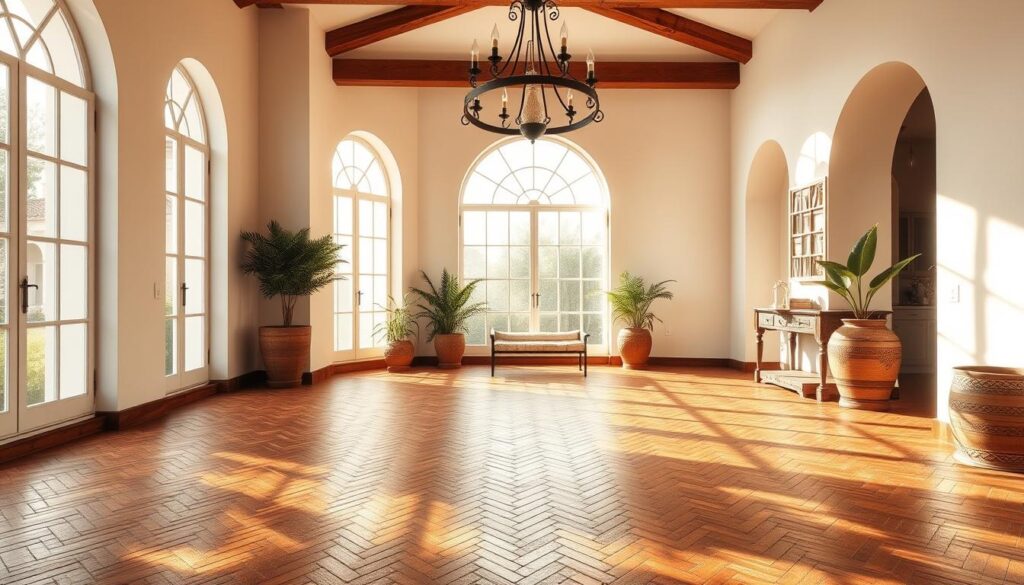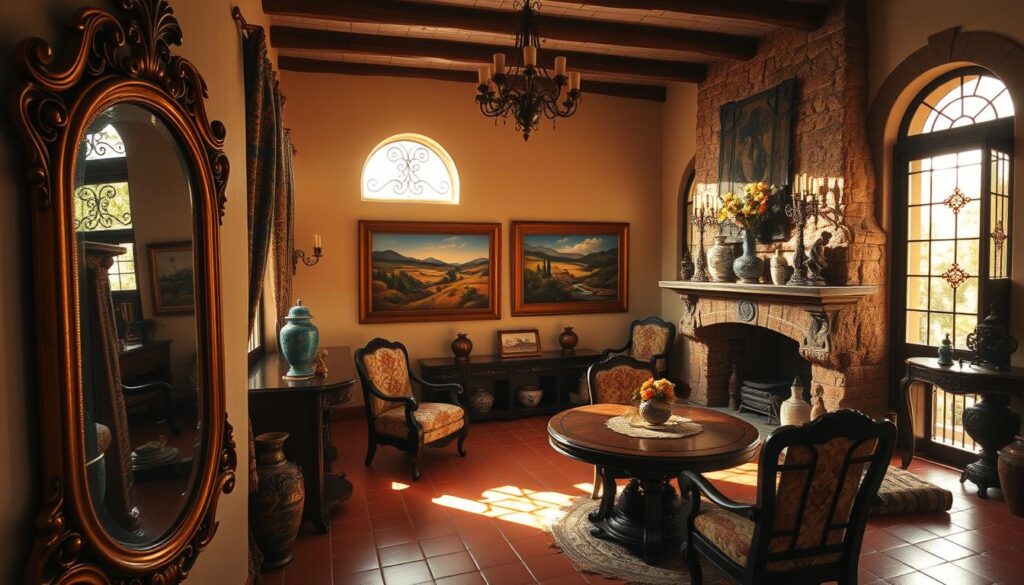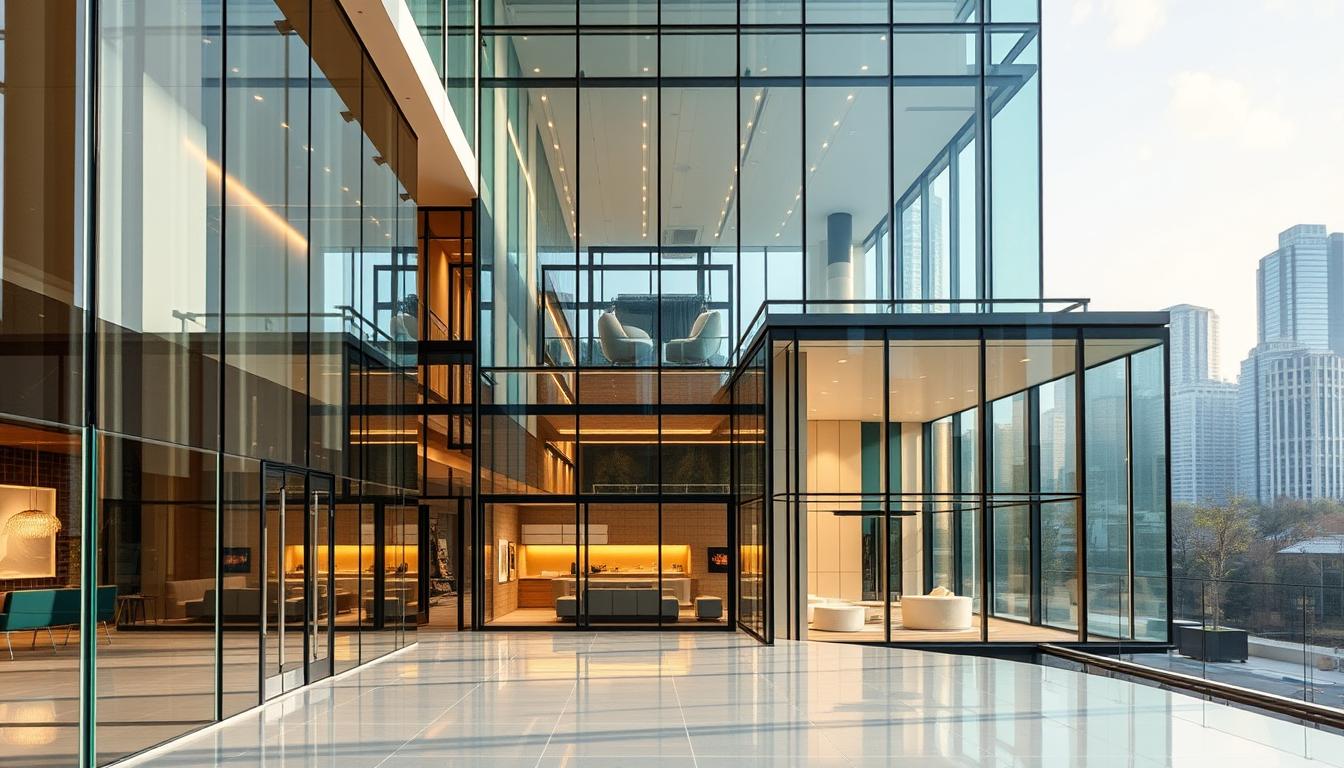Did you know that Spanish-style homes interior designs have become very popular lately? Homeowners want to add warmth and character to their homes.
Our guide is here to help you explore Spanish-style interior design. It offers insights and inspiration to make your home better.
By using key elements of this timeless aesthetic, you can make your home beautiful and traditional.
Key Takeaways
- Discover the essence of Spanish-style interior design
- Learn how to incorporate traditional elements into your home
- Understand the benefits of adopting this timeless aesthetic
- Explore ways to balance authenticity with personal style
- Create a warm and inviting living space
Understanding Spanish-Style Interior Design
Exploring Spanish-style interior design takes us to a world where tradition meets timeless beauty. This style is known for its rich history, bright colors, and detailed designs. It stands out as a unique and captivating choice.
Key Characteristics of Spanish-Style Homes
Spanish-style homes have distinct features. These include:
- Ornate Details: Intricate woodwork, carved doors, and detailed ironwork are hallmarks of this style.
- Vibrant Colors: Earthy tones combined with vibrant hues create a warm and inviting atmosphere.
- Textured Materials: The use of various textures, such as wood, stone, and tile, adds depth to the interiors.
These elements blend to make a space that feels both luxurious and cozy. It reflects the Mediterranean interior design influence.
The Influence of Spanish Colonial Architecture
Spanish Colonial architecture has deeply influenced Spanish-style interior design. The style draws from the grand architectural achievements of the Spanish colonies. It includes elements such as:
- Arches and domes, which add a sense of grandeur.
- Heavy, carved wooden doors and furniture, which bring warmth and character.
- Tiled floors and walls, which contribute to the style’s distinctive look and feel.
Understanding these influences helps us appreciate the complexity and beauty of spanish decor. It shows how it continues to inspire modern interior design.
Historical Roots of Spanish-Style Homes
The history of Spanish-style homes is a captivating story of cultural mix and architectural growth. These homes, known for their rustic beauty and welcoming interiors, have a long and interesting past.
The Origins of Spanish Colonial Design
Spanish Colonial design started in the 16th century. Spanish explorers brought their architectural styles to the Americas. This mix of Moorish, Gothic, and Renaissance styles created a unique look known as Spanish Colonial.
The style evolved by using local materials and adapting to new climates. It became known for rustic architecture and earthy tones, making Spanish-style homes special.
Significant Regions Influencing the Style
Many regions shaped Spanish Colonial design. The southern United States, like Florida and California, developed unique sub-styles. These were influenced by local cultures and climates.
In these areas, the Spanish house interior featured terra cotta tiles, wooden beams, and colorful textiles. This showed the cultural diversity of the regions.
Looking into the history of Spanish-style homes, we see their lasting charm. They mix traditional elements with local touches, creating a warm and welcoming space. This is truly Spanish in spirit.
Essential Elements of Spanish-Style Interiors
Spanish-style home design is known for its rich history and beauty. The interiors are warm and inviting. This is thanks to the choice of textures, materials, and colors.
Textures and Materials Commonly Used
Spanish interiors feature rich textures and authentic materials. Wood, like walnut and mahogany, adds warmth. Stone and terra cotta bring a natural feel indoors.
Mediterranean style furniture adds to the authenticity. It’s known for intricate designs and comfort. This furniture makes homes feel welcoming.
| Material | Characteristics | Common Uses |
|---|---|---|
| Wood | Warmth, durability, can be carved or stained | Furniture, flooring, beams |
| Stone | Durable, natural beauty, can be textured | Fireplaces, flooring, walls |
| Terra Cotta | Earthy tones, rustic feel, porous | Pottery, tile work, decorative elements |
Color Palettes: Earthy Tones and Vibrant Hues
Spanish homes blend earthy tones with vibrant colors. Earthy shades like terracotta red and golden yellow remind us of Spain’s countryside. These colors are enhanced by the vibrant hues in tiles and textiles.
When designing a Spanish style homes interior, balance is key. Mixing earthy tones with bright colors creates a warm, inviting space. It’s both authentic and elegant.
Furniture Selection for Spanish-Style Spaces
Choosing the right furniture is key to a Spanish-style space that’s both welcoming and stylish. The right pieces can make you feel like you’re in Spain, surrounded by warmth and tradition.
Choosing Rustic and Heirloom Pieces
Rustic and heirloom furniture is central to Spanish decor. These items often have intricate carvings and are crafted from solid, rich woods like walnut or mahogany. Look for furniture with character, like visible grain or antique finishes.
Heirloom pieces bring history and authenticity to your home. Consider adding antique furniture or vintage items to enhance the look. Remember, “The best furniture is a reflection of the people who have lived with it.”
“Furniture is the silent witness to the passage of time.”
Incorporating Modern Elements
While traditional pieces are important, adding modern elements keeps your space feeling fresh. Modern furniture with clean lines contrasts well with ornate, traditional items. The goal is to find a balance between old and new.
For instance, pair a rustic wooden dining table with modern chairs for a sleek look. Or, update a vintage sofa with contemporary fabric for a mix of old and new. Designer Isabel Marant suggests mixing styles for a unique space.
When adding modern touches, think about Spanish decor’s typical materials like terracotta, wood, and wrought iron. Combining these with modern furniture creates a space that’s both authentic and modern.
Importance of Outdoor Spaces in Spanish Design
Outdoor spaces are key in Spanish-style homes. They blend indoor and outdoor living perfectly. This design creates a balance between inside and outside, making outdoor areas essential.
In Mediterranean interior design, outdoor areas are vital. They’re cozy and inviting, often with rustic architecture like terracotta tiles and wooden beams.
Designing Cozy Patios and Terraces
Creating cozy patios and terraces is crucial in Spanish design. These spots are great for relaxing and having fun. They offer a calm escape from everyday life.
- Use natural materials like stone and wood for a warm feel.
- Choose comfy seating with plush furniture and soft cushions.
- Add terracotta pots, lanterns, and fountains for extra charm.
Andalusian architect, Leopoldo Torres Balbás said, “The patio is the heart of the Spanish house.” This shows how important outdoor spaces are in Spanish design.
Integrating Gardens and Landscaping
Adding gardens and landscaping is vital in Spanish outdoor spaces. Greenery and flowers make the area beautiful and peaceful.
- Choose Mediterranean plants like olive trees and lavender.
- Include water features like fountains for a calming touch.
- Use stone and gravel for pathways and to define areas.
By designing outdoor spaces well, homeowners can link indoors and outdoors smoothly. This boosts the beauty of their Spanish-style home.
Flooring Options for Authentic Spanish Interiors
The flooring in a Spanish-style home is more than just functional. It’s a key design feature that adds to the ambiance. Choosing the right flooring is crucial. It sets the tone for the space, often paired with Mediterranean style furniture.

Tile Choices: Saltillo vs. Ceramic
Tile flooring is a must in Spanish interiors. Saltillo and ceramic tiles are top choices. Saltillo tiles, made from terracotta, bring a rustic, earthy feel to homes.
They have warm tones and natural variations in color and texture. Ceramic tiles offer a durable and versatile option. They can look like Saltillo tiles but last longer and are easier to clean.
“The choice between Saltillo and ceramic tiles often comes down to the desired level of authenticity versus practicality.”
The Charm of Natural Wood Flooring
Natural wood flooring adds warmth and character to a Spanish-style home. The rich tones of wood match the earthy hues found in Spanish interiors. This creates a cozy and inviting atmosphere.
Wood flooring works well with Mediterranean style furniture. It enhances the overall look. When choosing wood flooring, think about the type of wood and the finish.
A distressed or hand-scraped finish adds rustic charm. A smoother finish gives a more contemporary look. The right flooring choice balances authenticity, durability, and personal taste. It creates a beautiful and inviting space that reflects Spanish design’s warmth and elegance.
Lighting Techniques for Ambiance
Lighting is key in Spanish-style interior design. It creates a warm and welcoming space. The right lighting can make a room cozy and inviting.
Fixtures that Enhance Spanish Aesthetics
The right lighting fixtures can really enhance a home’s Spanish look. Wrought iron and antique metal fixtures add elegance. Lantern-style lights, whether hanging or on walls, are typical of Spanish-style lighting.
These fixtures light up the room and add to the design. For a true Spanish look, try forja (wrought iron) lighting. It’s ornate and detailed, adding richness. Dimmers with these fixtures help adjust the light for different times.
Natural Light: Bringing the Outdoors In
Maximizing natural light is crucial in Spanish-style homes. Large windows, courtyards, and skylights bring the outdoors in. They light up the space and show off the home’s beauty.
Adding solariums or sunrooms connects indoors to outdoors. These areas let you enjoy natural light and nature. They make the indoor and outdoor spaces feel like one.
Choosing the right lighting and using natural light makes a home warm and inviting. It feels connected to the outdoors.
Wall Decor and Art in Spanish Homes
Wall decor and art are key in Spanish homes, showing off the Mediterranean interior design style. Spain’s rich culture shines through in the decorations used in these homes.

Using Textiles and Tapestries
Textiles and tapestries are essential in Spanish decor, bringing warmth and character to walls. They often have intricate patterns and bright colors, showing Spain’s history and culture. Using these textiles makes a home feel cozy and welcoming, truly Spanish.
A tapestry can be a room’s centerpiece, catching the eye with its detailed work. We can also use embroidery and other textile arts to add depth and interest to our walls.
| Textile Type | Characteristics | Use in Spanish Decor |
|---|---|---|
| Tapestries | Intricate patterns, vibrant colors | Focal points, adds warmth |
| Embroidery | Detailed craftsmanship, varied designs | Adds depth, layers of interest |
| Kilim | Flat weave, geometric patterns | Wall hangings, adds texture |
Choosing Art that Reflects Culture
Choosing art that shows Spanish culture is key for a true Spanish-style home. Art that mirrors Spain’s history, architecture, and daily life can really make a room feel special. For those wanting to add Mediterranean-style interior design, picking the right art is important.
Look for art with traditional Spanish motifs, like Moorish patterns or scenes from Spanish literature. These pieces not only look great but also tell the story of Spain’s culture.
- Look for art pieces that reflect Spanish history and culture.
- Consider the work of Spanish artists or those influenced by Spanish culture.
- Incorporate traditional motifs and patterns into your art selection.
By carefully choosing wall decor and art, we can make Spanish-style homes that are not just beautiful but also full of cultural meaning.
Trends in Modern Spanish-Style Interiors
Rustic architecture is still a big influence in modern Spanish-style interiors, but with a new twist. We see the essence of Spanish-style homes being updated to fit today’s tastes. Yet, it still keeps its rich heritage.
Blending Traditional and Contemporary Styles
The modern Spanish-style interior is all about finding a balance. It combines traditional elements with modern design. This mix is seen in rustic wooden beams paired with sleek, modern furniture.
This blend creates a unique look. It respects the past while welcoming the present.
Key Elements of Modern Spanish-Style Interiors:
- Use of earthy tones and vibrant hues
- Incorporation of natural materials like wood and stone
- Blend of antique and modern furniture pieces
- Emphasis on outdoor spaces and natural light
Sustainable Practices in Design
Sustainability is key in modern Spanish-style interiors. We’re moving towards eco-friendly materials and energy-efficient designs. These changes help reduce our environmental impact and make living spaces better.
| Sustainable Practice | Description | Benefit |
|---|---|---|
| Eco-friendly Materials | Use of reclaimed wood, recycled materials | Reduces waste and preserves natural resources |
| Energy Efficiency | Installation of solar panels, energy-efficient appliances | Lowers energy consumption and costs |
| Natural Light and Ventilation | Strategic placement of windows and skylights | Enhances ambiance and reduces need for artificial lighting |
As design tastes evolve, it’s exciting to see modern Spanish-style interiors adapt. By mixing old and new and focusing on sustainability, we can make spaces that are both stunning and good for the planet.
Tips for Creating a Cohesive Spanish-Style Look
To get a cohesive Spanish-style look, balance is key. We’ll look at how to mix furniture and decor. This will help you create a harmonious space.
Balancing Elements
When mixing pieces, think about the look you want. Mix rustic wood with bright colors and earthy tones for warmth. Adding modern touches can bring sophistication.
Staying True to Tradition
It’s important to keep traditional Spanish design in mind. Use classic features like arches and columns. Stick to materials like terracotta and wood for authenticity.
By balancing elements and keeping to tradition, your home will be warm and full of character. It will show off the beauty of mediterranean style furniture and the timeless charm of traditional decor.


